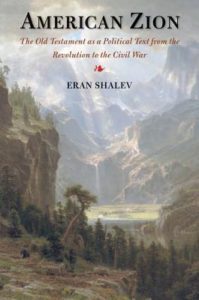Title: American Zion: The Old Testament as a Political Text from the Revolution to the Civil War
Author: Eran Shalev
Publisher: Yale University Press
Genre: American religious history
Year published: 2014
Pages: 256
Reviewed by Erik Champenois
American Zion covers the political uses of the Old Testament in the United States from the Revolution to the Civil War in five thematically oriented chapters. The first chapter covers the merging of classical republicanism with the Old Testament during the American Revolution, showing how classical Roman and republican themes of virtue and corruption were fused with and read into Old Testament stories. The second chapter covers ancient Israel as a political model to the early republic, with the Israelite tribes being frequently compared to the American states, and the political structures of ancient Israel said to be similar to those of the United States. Particularly fascinating is Shalev’s treatment of Mordecai Manuel Noah, who in the 1820s declared himself “judge of Israel” and called for the gathering of Jews throughout the world to come to his island in New York, where a “Jewish Nation” was to be established under the U.S. Constitution.
The third and fourth chapters are of particularly interest to Mormons. In the third, Shalev covers the tradition of pseudobiblicism in the early republic – when articles, short stories, and even a few longer books portraying events from American history were written in the grammar and style of the King James Bible. Shalev connects the Book of Mormon to this tradition as the Book of Mormon similarly uses the pseudobiblical style to advance its sacred narrative about ancient and modern America. Likewise, the fourth chapter covers the common American belief (originating centuries earlier but particularly common in the early nineteenth century) that the Native Americans were descendants of the lost tribes. Which of course serves as cultural background important to the Book of Mormon’s narrative and to its reception history. Shalev is respectful to the Mormon faith as he places the “creation (translation)” of the Book of Mormon within its time.
Finally, the fifth and last chapters covers the decline of the use of the Old Testament as a political text alongside the increased use of the New Testament. Shalev sees the Great Awakening as pivotal in making the United States a “Jesus” nation, focused more on the saving grace of the New Testament than on the political narratives of the Old. He further argues that debates about whether or not the Bible justified slavery hastened the transition towards the New Testament, as opponents of slavery sought to explain away slavery in the Old Testament as being irrelevant to slavery in the United States, and drew more on the example of Jesus in the New Testament than on Old Testament narratives. Meanwhile, African Americans continued to hold onto the Old Testament as their primary text, with the story of the Exodus being the foremost text in representing escape from the evils of slavery/Egypt/America.
Highly recommended reading for anyone interested in the history of the Bible in the United States, as well as in the cultural origins of Mormonism.

